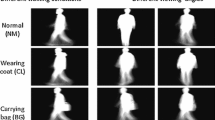Abstract
With the rapid development of surveillance technology, there are often several cameras in one scenario. The multi-camera usage to perform gait recognition becomes a challenge problem. This paper studies multi-camera gait recognition via structure sparsity. For the multi-camera structure in the training set, we propose a structure sparsity algorithm to learn informative and discriminative sparse representations; and for the structure in the testing set, we develop a new classification criteria based on the reconstruction error of learned sparse representations. In addition, we learn a dictionary from the original gait data to further improve recognition accuracy meanwhile reduce computational cost. Experimental results show that the proposed method can efficiently deal with the multi-camera gait recognition problem and outperforms the state-of-the-art sparse representation methods.
Access this chapter
Tax calculation will be finalised at checkout
Purchases are for personal use only
Preview
Unable to display preview. Download preview PDF.
Similar content being viewed by others
References
Wang, L., Tan, T., Ning, H., Hu, W.: Silhouette Analysis-based Gait Recognition for Human Identification. TPAMI 25(12), 1505–1518 (2003)
Zhang, R., Vogler, C., Metaxas, D.: Human Gait Recognition. In: CVPRW, 18 pages (2004)
Zhao, G., Liu, G., Li, H., Pietikainen, M.: 3D Gait Recognition using Multiple Cameras. In: FGR, pp. 529–534 (2006)
Han, J., Bhanu, B.: Individual Recognition Using Gait Energy Image. TPAMI 28(2), 316–322 (2006)
Tao, D., Li, X., Wu, X., Maybank, S.J.: General Tensor Discriminant Analysis and Gabor Features for Gait Recognition. TPAMI 29(10), 1700–1715 (2007)
Wang, C., Zhang, J., Wang, L., Pu, J., Yuan, X.: Human Identification Using Temporal Information Preserving Gait Template. TPAMI (99) (2011)
Lei, Z., Chu, R.F., He, R., Liao, S.C., Li, S.: Face Recognition by Discriminant Analysis with Gabor Tensor Representation. In: Advances in Biometrics (2007)
Kusakunniran, W., Wu, Q., Zhang, J., Li, H.: Support Vector Regression for Multi-view Gait Recognition based on Local Motion Feature Selection. In: CVPR, pp. 974–981 (2010)
Kusakunniran, W., Wu, Q., Zhang, J., Li, H.: Gait Recognition under Various Viewing Angles based on Correlated Motion Regression. TCSVT (99), 1–1 (2012)
Wright, J., Yang, A.Y., Ganesh, A., Sastry, S.S., Ma, Y.: Robust Face Recognition via Sparse Representation. TPAMI 31(2), 210–227 (2009)
Wright, J., Ma, Y., Mairal, J., Sapiro, G., Huang, T.S., Yan, S.: Sparse Representation for Computer Vision and Pattern Recognition. Proceedings of the IEEE 98(6), 1031–1044 (2010)
He, R., Zheng, W.-S., Hu, B.-G., Kong, X.W.: A Regularized Correntropy Framework for Robust Pattern Recognition. Neural Computation 23(8), 2074–2100 (2011)
He, R., Hu, B.-G., Zheng, W.-S., Kong, X.W.: Robust Principal Component Analysis Based on Maximum Correntropy Criterion. IEEE Transactions on Image Processing 20(6), 1485–1494 (2011)
Yang, Q., Xue, D.-Y., Cui, J.-J.: Gait Recognition Using Sparse Representation. Journal of Northeastern University(Natural Science), 136–139 (2012)
Gong, M., Xu, Y., Yang, X., Zhang, W.: Gait Identification by Sparse Representation. FSKD 3, 1719–1723 (2011)
Nie, F., Huang, H., Cai, X., Ding, C.: Efficient and Robust Feature Selection via Joint l 2,1 − Norms Minimization. In: NIPS, vol. 23, pp. 1813–1821 (2010)
He, R., Sun, Z.N., Tan, T.N., Zheng, W.S.: Recovery of Corrupted Low-Rank Matrices via Half-Quadratic based Nonconvex Minimization. In: IEEE CVPR (2011)
He, R., Tan, T.N., Wang, L., Zheng, W.S.: L21 Regularized Correntropy for Robust Feature Selection. In: IEEE CVPR (2012)
Zheng, S., Huang, K.Q., Tan, T.N., He, R., Zhang, J.: Robust View Transformation Model for Gait Recognition. In: ICIP (2011)
Kusakunniran, W., Wu, Q., Li, H.D., He, R., Zhang, J.: Multiple Views Gait Recognition Using View Transformation Model Based on Optimized Gait Energy Image. In: IEEE ICCV (2009)
Author information
Authors and Affiliations
Editor information
Editors and Affiliations
Rights and permissions
Copyright information
© 2012 Springer-Verlag Berlin Heidelberg
About this paper
Cite this paper
Yin, Q., Sun, R., Wang, L., He, R. (2012). Structure Sparsity for Multi-camera Gait Recognition. In: Liu, CL., Zhang, C., Wang, L. (eds) Pattern Recognition. CCPR 2012. Communications in Computer and Information Science, vol 321. Springer, Berlin, Heidelberg. https://doi.org/10.1007/978-3-642-33506-8_33
Download citation
DOI: https://doi.org/10.1007/978-3-642-33506-8_33
Publisher Name: Springer, Berlin, Heidelberg
Print ISBN: 978-3-642-33505-1
Online ISBN: 978-3-642-33506-8
eBook Packages: Computer ScienceComputer Science (R0)




